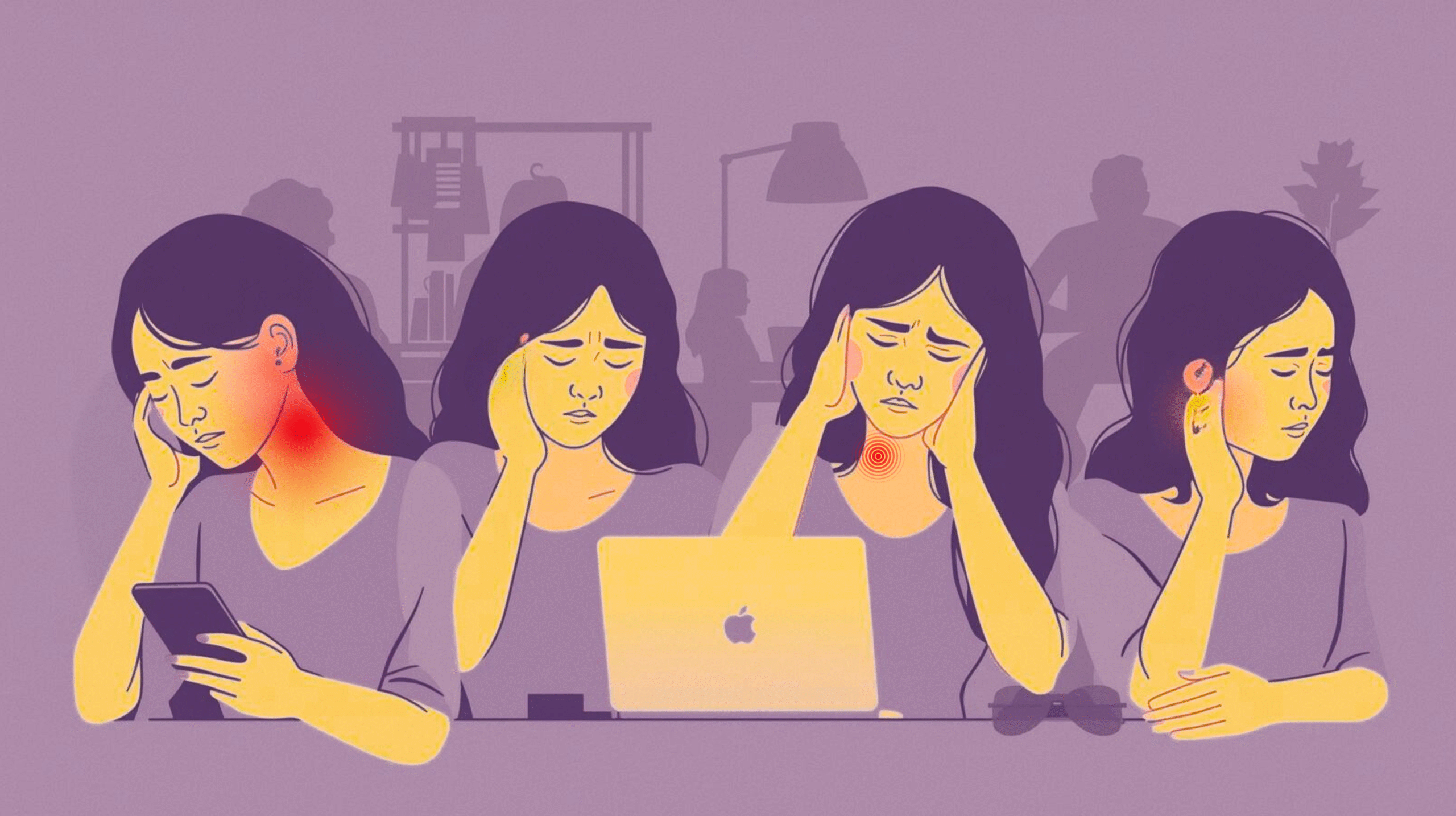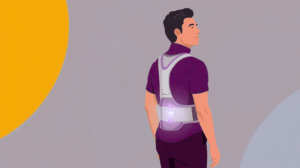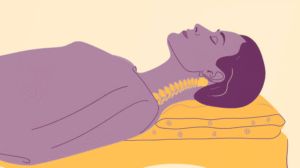Growing Prevalence of Neck Discomfort
Neck pain is a musculoskeletal issue that has become widespread in the present day. Research has revealed that over two-thirds of the population experience neck pain at one time of their lives. This issue is becoming increasingly common with the growing use of technology and the lack of activity of people [1]. The large use of smartphones, computers, and tablets has given rise to new issues especially to young adults and the workforce who spend much of their time standing or sitting.
The problem affects several age categories. Using screens for the long term can result in the development of “tech neck” among the young population, whereas elderly individuals stand to be more vulnerable to degenerative conditions such as arthritis and cervical spondylosis [2].
Why Addressing Neck Discomfort Is Important?
Neck pain should not be treated as a minor issue; it may have an influence on everyday life, including work, and quality of life. Individuals who complain of chronic neck pain usually claim problems in sleeping, concentrating at work place, and in leisure time. Neck pain may become chronic pain that can lead to more medical bills, more visits to the physician and even result in mental health issues such as depression and anxiety, when left untreated.
Musculoskeletal issues such as neck pain can contribute to missed working days and reduced productivity. According to the Global Burden of Disease Study, neck pain is among the chief causes that make people incapable of working [3]. This serves to demonstrate the need to begin treating and preventing this disease as early as possible.
Purpose of the Article
The purpose of this article is to provide readers with a comprehensive understanding of neck discomfort. Specifically, it will cover:
- A clear definition of neck discomfort and its associated symptoms.
- The most common causes, including poor posture, stress, injuries, and medical conditions.
- Diagnostic approaches used by healthcare professionals.
- Evidence-based treatment options, ranging from home remedies to professional care.
- Lifestyle and ergonomic adjustments to prevent recurrence.
- Guidelines on when to seek medical help.
By the end of this discussion, readers will have actionable knowledge to better manage neck discomfort, enhance cervical spine health, and improve their overall well-being.
Understanding Neck Discomfort
Definition of Neck Discomfort
Neck discomfort refers to any sensation of pain, stiffness, or soreness in the cervical region; the area spanning from the base of the skull to the upper shoulders. The cervical spine consists of seven vertebrae (C1–C7), intervertebral discs, ligaments, muscles, and nerves that support head movement and posture. Discomfort in this area may arise from muscular strain, joint dysfunction, nerve irritation, or structural abnormalities [4].
Unlike acute injuries, which typically result in sharp, localized pain, neck discomfort often manifests gradually due to repetitive strain, poor posture, or underlying conditions. It may present as dull aching, restricted mobility, or radiating pain extending to the shoulders and arms.
Common Symptoms Associated With Neck Discomfort
Symptoms of neck discomfort vary in severity and duration but often include:
- Limited mobility: Difficulty turning the head from side to side or tilting it forward and backward.
- Radiating pain: Pain that travels into the shoulders, arms, or even hands, suggesting nerve involvement.
- Headaches: Cervicogenic headaches are commonly linked to neck strain.
- Muscle tightness: A constant feeling of stiffness or knots in the neck and upper back.
- Numbness or tingling: Often indicates nerve compression in the cervical region.
Recognizing these symptoms early helps prevent the escalation of temporary discomfort into chronic conditions.
Short-Term vs. Chronic Neck Discomfort
Neck discomfort can be classified into two main categories:
- Short-term (acute) discomfort: Usually results from sudden strain, awkward sleeping positions, or minor injuries. It typically resolves within days to weeks with rest, stretching, and simple remedies.
- Chronic discomfort: Lasts for more than three months and often stems from degenerative conditions, repetitive strain injuries, or unresolved posture problems. Chronic discomfort requires a more structured approach, including medical evaluation, physiotherapy, and lifestyle changes [5].
This distinction is essential because while short-term discomfort may be self-managed, chronic cases often demand professional intervention.
Causes of Neck Discomfort
Neck discomfort often results from lifestyle habits, injuries, or medical conditions. Common causes include:
Poor Posture
- Tech neck: Forward head posture from phones and laptops increases strain on cervical muscles [6].
- Slouching: Sitting hunched over while working or driving weakens support muscles and causes stiffness.
Work-Related Stress and Tension
- Prolonged sitting: Static positions reduce circulation and strain neck muscles.
- Stress/anxiety: Emotional tension tightens shoulder and neck muscles [7].
- Repetitive tasks: Typing or cradling a phone worsens strain.

Sleeping Positions and Pillows
- Improper pillows: Too high/flat pillows disrupt cervical alignment.
- Sleeping on stomach: Rotates neck unnaturally for hours.
- Poor mattresses: Reduce spinal support.
Injuries and Accidents
- Whiplash: Sudden jerks from car accidents damage muscles and ligaments.
- Sports strain & trauma: Heavy lifting, falls, or collisions increase risk.
Medical Conditions
- Arthritis: Causes stiffness and reduced flexibility.
- Cervical spondylosis: Age-related disc wear and tear.
- Herniated discs: Compress nerves, leading to radiating pain.
- Fibromyalgia: Widespread muscle pain with frequent neck stiffness.
Symptoms and Diagnosis
Neck discomfort presents in different ways, and recognizing the signs helps determine whether medical evaluation is needed.
Recognizing Signs of Neck Discomfort
Typical symptoms include:
- Pain and stiffness: Ranging from mild soreness to sharp, debilitating pain.
- Limited range of motion: Difficulty turning the head or looking up and down.
- Tingling or numbness: Often indicates nerve compression.
- Headaches: Particularly tension headaches or cervicogenic headaches linked to neck muscle strain [8].
- Radiating pain: Extending to shoulders, arms, or even hands.
Self-Assessment and Warning Signals
Individuals can self-monitor their symptoms to determine severity. Warning signals include:
- Persistent pain lasting more than a week despite home remedies.
- Discomfort interfering with daily tasks, such as driving or working.
- Sudden, severe pain after minor movement.
- Weakness in arms or loss of coordination, which may signal nerve or spinal cord involvement.
These red flags should not be ignored and require professional evaluation.
Medical Diagnosis Methods
Healthcare professionals use a combination of history-taking, physical exams, and imaging to diagnose neck discomfort.
- Physical examinations: Assess muscle strength, reflexes, range of motion, and tender points.
- X-rays: Reveal structural issues such as arthritis or bone spurs.
- Magnetic Resonance Imaging (MRI): Provides detailed images of discs, nerves, and soft tissues.
- CT scans: Useful for detecting fractures or bone abnormalities.
- Electromyography (EMG): Evaluates nerve function when numbness or tingling is present.
A precise diagnosis ensures the correct treatment plan, especially for chronic or severe cases
Treatment Options for Neck Discomfort
Neck discomfort can often be managed with simple measures, though persistent or severe cases may need professional care.
Home Remedies
- Cold & heat therapy: Cold packs reduce swelling; heat relaxes muscles and improves circulation.
- Gentle massage & rest: Light massage eases stiffness, while moderate rest helps recovery.
- Topical creams: Menthol or capsaicin gels provide temporary relief.
Over-the-Counter Solutions
- NSAIDs (ibuprofen, naproxen): Reduce pain and inflammation.
- Acetaminophen: Pain relief without anti-inflammatory effect.
- Short-term muscle relaxants: For severe spasms (use cautiously).
Physical Therapy
- Stretching & strengthening: Boost flexibility, posture, and muscle support.
- Postural retraining: Corrects daily habits that strain the neck.
Evidence shows exercise-based therapy reduces chronic pain and improves mobility.
Professional Treatments
- Chiropractic care: Restores alignment, relieves nerve irritation.
- Acupuncture: Promotes healing and eases tension.
- Massage therapy: Reduces stiffness and improves circulation.
Surgical Options (Rare)
- Disc replacement or spinal fusion may be needed for severe cases with nerve compression or structural damage. Surgery is reserved for patients unresponsive to conservative care.
Lifestyle and Ergonomic Solutions
Beyond treatments, lifestyle adjustments and ergonomic improvements play a central role in preventing neck discomfort and promoting long-term cervical health.
Workplace Ergonomics
- Proper desk and monitor setup: The computer screen should be at eye level to avoid tilting the head downward.
- Ergonomic chairs: Adjustable chairs with lumbar and neck support reduce postural strain.
- Supportive cushions: Neck pillows or back rests can encourage alignment during long work hours.
Studies confirm that ergonomic interventions significantly reduce neck and back discomfort among office workers [9].
Daily Posture Correction
- Head alignment: Keeping the ears aligned with the shoulders reduces forward head posture.
- Frequent position changes: Avoid sitting in the same posture for hours; micro-movements and stretching breaks are essential.
- Driving ergonomics: Adjust car seats to ensure the neck and back are supported without forcing the head forward.
Posture correction takes time and habit-building, but the benefits extend beyond neck comfort to overall spinal health.
Exercise and Stretching Routines
Regular movement is a powerful preventive tool:
- Chin tucks: Strengthen deep neck flexors and reduce forward head posture.
- Shoulder rolls and blade squeezes: Release tension in upper back muscles.
- Neck rotations and tilts: Maintain flexibility and prevent stiffness.
Yoga, Pilates, and tai chi are also effective for improving posture, balance, and reducing neck strain.
Stress Management Techniques
Since stress often manifests as muscle tension in the neck and shoulders, managing stress is a preventive approach.
- Breathing exercises: Deep diaphragmatic breathing calms the nervous system and relaxes muscles.
- Yoga and meditation: Proven to reduce stress levels and associated muscle tightness [10].
- Mindfulness practices: Increase awareness of posture and reduce unconscious tension.
Prevention of Neck Discomfort
Preventing neck discomfort requires a proactive approach combining ergonomics, healthy habits, and physical conditioning. By making small but consistent adjustments, individuals can significantly reduce the risk of developing chronic neck pain.
Proper Sleeping Positions and Pillow Use
- Right pillow choice: A medium-firm pillow that supports the natural curve of the neck is ideal. Memory foam and cervical pillows are often recommended.
- Sleeping positions:
- Best: Sleeping on the back or side, keeping the neck aligned with the spine.
- Avoid: Sleeping on the stomach, as it forces the neck into rotation for long hours.
- Studies show that poor pillow support contributes to morning stiffness and chronic cervical issues [11].
Regular Movement Breaks During Work
- Sitting for extended hours at a desk or computer is one of the leading causes of neck discomfort.
- Experts recommend taking a short break every 45-60 minutes to stretch or walk.
- Simple desk stretches such as rolling shoulders, rotating the neck gently, or extending the arms overhead can relieve accumulated strain.
Safe Lifting Techniques
Improper lifting mechanics often strain not only the back but also the neck.
- Keep heavy loads close to the body.
- Avoid twisting the neck or bending it forward when carrying weight.
- Use the legs and hips for lifting power, not the spine or neck muscles.
Workplace safety guidelines emphasize that training in lifting techniques reduces musculoskeletal injuries [12].
Building Neck Strength
Strengthening neck and upper back muscles helps maintain posture and prevent fatigue.
- Resistance band exercises for neck and shoulder stability.
- Isometric holds to build endurance in neck stabilizers.
- Incorporating these into a weekly routine enhances resilience against posture-related strain
When to See a Doctor?
While mild neck pain is common and often resolves with self-care, there are situations when professional evaluation becomes essential.
Persistent or Severe Discomfort
- If pain lasts longer than two weeks despite home remedies.
- Severe pain that interferes with sleep, work, or daily activities.
Accompanying Symptoms
- Numbness or tingling in the arms or hands.
- Weakness in the shoulders or upper limbs.
- Dizziness, loss of balance, or headaches related to neck tension.
These could indicate nerve compression, disc problems, or circulatory issues requiring medical care.
Identifying Red Flags
Seek immediate medical attention if:
- Sudden sharp pain appears after a fall or accident.
- Neck discomfort is accompanied by fever, weight loss, or difficulty swallowing.
- There is loss of bladder or bowel control (possible spinal cord involvement).
According to the American Academy of Orthopaedic Surgeons, these warning signs should not be ignored, as they may suggest serious underlying conditions [13].
Conclusion
The neck pain is highly prevalent these days, and it may be caused by factors such as poor posture, stress, sedentary lifestyle and spending excessive time in front of the screen. Failure to get treatment may lead to chronic pains in the neck, reduced movements and permanent spinal complications.
An integrated approach can reduce neck pain. Self-care is the first and foremost step which involves physical activity. Ergonomics and medical assistance are additional measures. Individuals are able to keep their backs healthy, reduce pain, and are able to live better lives altogether by preventing issues and seeking treatment on time.
Neck pain often comes with back pain. Solutions are there for that too. Learn how to prevent back pain effectively:
Frequently Asked Questions:
1. What are the most common causes of neck discomfort?
The most frequent causes include poor posture (especially from prolonged screen use), stress-related muscle tension, improper sleeping positions, injuries such as whiplash, and medical conditions like arthritis or herniated discs. Among these, posture-related strain is considered the most widespread in modern lifestyles.
2. How do I know if my neck discomfort is serious?
Neck pain is considered serious if it:
- Persists longer than two weeks.
- Spreads to the arms or hands.
- Is associated with numbness, weakness, or dizziness.
- Appears suddenly after trauma.
In such cases, professional medical evaluation is recommended.
3. What sleeping position is best for reducing neck pain?
Sleeping on the back or side with a supportive pillow is best. The pillow should keep the neck aligned with the spine. Stomach sleeping should be avoided because it forces the neck into unnatural rotation, which may worsen discomfort.
4. Can stress and anxiety cause neck tension?
Yes. Stress often triggers muscle tightening in the neck and shoulders. Chronic stress can lead to sustained tension, resulting in headaches and stiffness. Relaxation methods like meditation, yoga, and breathing exercises are effective in breaking this cycle.
5. How does poor posture contribute to neck discomfort?
Poor posture, such as forward head position or slouching, increases strain on cervical muscles and ligaments. For example, every inch the head moves forward adds up to 10 pounds of extra pressure on the neck. Over time, this leads to muscle fatigue, stiffness, and even disc problems.
References
- Kazeminasab, S., Nejadghaderi, S. A., Amiri, P., Pourfathi, H., Araj-Khodaei, M., Sullman, M. J., … & Safiri, S. (2022). Neck pain: global epidemiology, trends and risk factors. BMC musculoskeletal disorders, 23(1), 26. https://doi.org/10.1186/s12891-021-04957-4
- Hoy, D., Protani, M., De, R., & Buchbinder, R. J. B. P. (2010). The epidemiology of neck pain. Best practice & research Clinical rheumatology, 24(6), 783-792. https://doi.org/10.1016/j.berh.2011.01.019
- Safiri, S., Kolahi, A. A., Hoy, D., Buchbinder, R., Mansournia, M. A., Bettampadi, D., … & Ferreira, M. L. (2020). Global, regional, and national burden of neck pain in the general population, 1990-2017: systematic analysis of the Global Burden of Disease Study 2017. bmj, 368. doi: https://doi.org/10.1136/bmj.m791
- Cohen, S. P. (2015, February). Epidemiology, diagnosis, and treatment of neck pain. In Mayo Clinic Proceedings (Vol. 90, No. 2, pp. 284-299). Elsevier. https://doi.org/10.1016/j.mayocp.2014.09.008
- O’Riordan, C., Clifford, A., Van De Ven, P., & Nelson, J. (2014). Chronic neck pain and exercise interventions: frequency, intensity, time, and type principle. Archives of physical medicine and rehabilitation, 95(4), 770-783. https://doi.org/10.1016/j.apmr.2013.11.015
- Fiebert, I., Kistner, F., Gissendanner, C., & DaSilva, C. (2021). Text neck: An adverse postural phenomenon. Work, 69(4), 1261-1270. https://doi.org/10.3233/WOR-213547
- Nichols, L. A. (1964). The Emotions, Muscle Tension and Rheumatism. The Journal of the College of General Practitioners, 8(2), 156. https://pmc.ncbi.nlm.nih.gov/articles/PMC1878136/
- Becker, W. J. (2010). Cervicogenic headache: evidence that the neck is a pain generator. Headache: The Journal of Head and Face Pain, 50(4), 699-705. https://doi.org/10.1111/j.1526-4610.2010.01648.x
- Shariat, A., Cleland, J. A., Danaee, M., Kargarfard, M., Sangelaji, B., & Tamrin, S. B. M. (2018). Effects of stretching exercise training and ergonomic modifications on musculoskeletal discomforts of office workers: a randomized controlled trial. Brazilian journal of physical therapy, 22(2), 144-153. https://doi.org/10.1016/j.bjpt.2017.09.003
- Khan, A. A., Srivastava, A., Passi, D., Devi, M., Chandra, L., & Atri, M. (2018). Management of myofascial pain dysfunction syndrome with meditation and yoga: Healing through natural therapy. National journal of maxillofacial surgery, 9(2), 155-159. DOI: 10.4103/njms.NJMS_25_17
- Gordon, S. J., Grimmer-Somers, K. A., & Trott, P. H. (2011). A randomized, comparative trial: does pillow type alter cervico-thoracic spinal posture when side lying?. Journal of Multidisciplinary Healthcare, 321-327. https://doi.org/10.2147/JMDH.S23028
- Tullar, J. M., Brewer, S., Amick III, B. C., Irvin, E., Mahood, Q., Pompeii, L. A., … & Evanoff, B. (2010). Occupational safety and health interventions to reduce musculoskeletal symptoms in the health care sector. Journal of occupational rehabilitation, 20(2), 199-219. https://doi.org/10.1007/s10926-010-9231-y
- American Academy of Orthopaedic Surgeons (2021). Neck pain. OrthoInfo. Retrieved from: https://orthoinfo.aaos.org/























